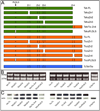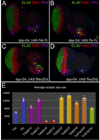A dissection of the teashirt and tiptop genes reveals a novel mechanism for regulating transcription factor activity
- PMID: 22019301
- PMCID: PMC3232042
- DOI: 10.1016/j.ydbio.2011.09.030
A dissection of the teashirt and tiptop genes reveals a novel mechanism for regulating transcription factor activity
Abstract
In the Drosophila eye the retinal determination (RD) network controls both tissue specification and cell proliferation. Mutations in network members result in severe reductions in the size of the eye primordium and the transformation of the eye field into head cuticle. The zinc-finger transcription factor Teashirt (Tsh) plays a role in promoting cell proliferation in the anterior most portions of the eye field as well as in inducing ectopic eye formation in forced expression assays. Tiptop (Tio) is a recently discovered paralog of Tsh. It is distributed in an identical pattern to Tsh within the retina and can also promote ectopic eye development. In a previous study we demonstrated that Tio can induce ectopic eye formation in a broader range of cell populations than Tsh and is also a more potent inducer of cell proliferation. Here we have focused on understanding the molecular and biochemical basis that underlies these differences. The two paralogs are structurally similar but differ in one significant aspect: Tsh contains three zinc finger motifs while Tio has four such domains. We used a series of deletion and chimeric proteins to identify the zinc finger domains that are selectively used for either promoting cell proliferation or inducing eye formation. Our results indicate that for both proteins the second zinc finger is essential to the proper functioning of the protein while the remaining zinc finger domains appear to contribute but are not absolutely required. Interestingly, these domains antagonize each other to balance the overall activity of the protein. This appears to be a novel internal mechanism for regulating the activity of a transcription factor. We also demonstrate that both Tsh and Tio bind to C-terminal Binding Protein (CtBP) and that this interaction is important for promoting both cell proliferation and eye development. And finally we report that the physical interaction that has been described for Tsh and Homothorax (Hth) do not occur through the zinc finger domains.
Copyright © 2010 Elsevier Inc. All rights reserved.
Figures








Similar articles
-
A critical role of teashirt for patterning the ventral epidermis is masked by ectopic expression of tiptop, a paralog of teashirt in Drosophila.Dev Biol. 2005 Jul 15;283(2):446-58. doi: 10.1016/j.ydbio.2005.05.005. Dev Biol. 2005. PMID: 15936749
-
Zinc-finger paralogues tsh and tio are functionally equivalent during imaginal development in Drosophila and maintain their expression levels through auto- and cross-negative feedback loops.Dev Dyn. 2009 Jan;238(1):19-28. doi: 10.1002/dvdy.21808. Dev Dyn. 2009. PMID: 19097089
-
Eye suppression, a novel function of teashirt, requires Wingless signaling.Development. 2002 Sep;129(18):4271-80. doi: 10.1242/dev.129.18.4271. Development. 2002. PMID: 12183379
-
Restriction of ectopic eye formation by Drosophila teashirt and tiptop to the developing antenna.Dev Dyn. 2009 Sep;238(9):2202-10. doi: 10.1002/dvdy.21927. Dev Dyn. 2009. PMID: 19347955 Free PMC article.
-
The mammalian zinc finger transcription factor Krüppel-like factor 3 (KLF3/BKLF).IUBMB Life. 2011 Feb;63(2):86-93. doi: 10.1002/iub.422. Epub 2011 Feb 24. IUBMB Life. 2011. PMID: 21360637 Review.
Cited by
-
The tiptop/teashirt genes regulate cell differentiation and renal physiology in Drosophila.Development. 2013 Mar;140(5):1100-10. doi: 10.1242/dev.088989. Development. 2013. PMID: 23404107 Free PMC article.
-
Allocation of distinct organ fates from a precursor field requires a shift in expression and function of gene regulatory networks.PLoS Genet. 2018 Jan 19;14(1):e1007185. doi: 10.1371/journal.pgen.1007185. eCollection 2018 Jan. PLoS Genet. 2018. PMID: 29351292 Free PMC article.
-
Down-regulation of the zinc-finger homeobox protein TSHZ2 releases GLI1 from the nuclear repressor complex to restore its transcriptional activity during mammary tumorigenesis.Oncotarget. 2016 Feb 2;7(5):5690-701. doi: 10.18632/oncotarget.6788. Oncotarget. 2016. PMID: 26744317 Free PMC article.
-
Homeotic Gene teashirt (tsh) has a neuroprotective function in amyloid-beta 42 mediated neurodegeneration.PLoS One. 2013 Nov 25;8(11):e80829. doi: 10.1371/journal.pone.0080829. eCollection 2013. PLoS One. 2013. PMID: 24282556 Free PMC article.
-
Drosophila Pax6 promotes development of the entire eye-antennal disc, thereby ensuring proper adult head formation.Proc Natl Acad Sci U S A. 2017 Jun 6;114(23):5846-5853. doi: 10.1073/pnas.1610614114. Proc Natl Acad Sci U S A. 2017. PMID: 28584125 Free PMC article.
References
-
- Aldaz S, Morata G, Azpiazu N. The Pax-homeobox gene eyegone is involved in the subdivision of the thorax of Drosophila. Development. 2003;130:4473–4482. - PubMed
-
- Alexandre E, Graba Y, Fasano L, Gallet A, Perrin L, De Zulueta P, Pradel J, Kerridge S, Jacq B. The Drosophila teashirt homeotic protein is a DNA-binding protein and modulo, a HOM-C regulated modifier of variegation, is a likely candidate for being a direct target gene. Mech Dev. 1996;59:191–204. - PubMed
-
- Bessa J, Carmona L, Casares F. Zinc-finger paralogues tsh and tio are functionally equivalent during imaginal development in Drosophila and maintain their expression levels through auto-and cross-negative feedback loops. Dev Dyn. 2009;238:19–28. - PubMed
MeSH terms
Substances
Grants and funding
LinkOut - more resources
Full Text Sources
Molecular Biology Databases
Miscellaneous

